Blister Mites
Blister mites are small, microscopic organisms that feed primarily on apple and pear trees, affecting both leaf and fruit. What makes them especially difficult to treat is the fact that they live under the epidermal layer of plant tissue which protects them from most fruit tree sprays, though they are vulnerable at some times of the year. Before we discuss how to treat your fruit trees for blister mites, lets talk about the symptoms, and how to identify whether or not your fruit trees have blister mites.
For regular updates regarding the care and pruning of fruit trees, please subscribe here:
Because blister mites are so small and can only be seen with the aid of a microscope, it is important to learn how to identify the symptoms. This is true for most fruit tree diseases. Sometimes just classifying the pest between insect, fungi, bacteria, etc. is good enough to find a treatment, but blister mites are often mis-classified as rust, a fungal disease. As a matter of fact, they are often called "pear rust mites" because of the similarities between the symptoms of rust and blister mites.
When blister mites first start feeding on new leaves in the spring, they will create a small light green blister on the surface of the leaf. As the summer progresses, these blisters will turn a rust color and then brown or black by the end of the season. The blisters are usually small and numerous. Although this pest will not kill a mature fruit tree, it's affect will limit the leaves ability to photosynthesize and will limit your tree's ability to grow and thrive. Blisters found on fruit can also affect aesthetics, thus diminishing the value and quality of your harvest. Fruit that has been blemished by blister mites is still safe for consumption, but some gardeners get squeamish about such things.
So how do you treat blister mites? Well, leaves fall and fruit is harvested in the autumn months and blister mites will fall away from the tree if they don't find a good place to over winter. Blister mites will migrate from leaves in the fall and overwinter in bud scales, and bark crevices close to a node. When spring arrives again, blister mites will repopulate new leaves when they emerge.
The best time to treat for blister mites is during their spring and fall migrations. This can be done organically with a dormant oil spray. Trees should be sprayed as close to leaf drop as possible and again in the spring when buds are swelling, but before blossoms emerge.
A consistent fall and spring treatment will not completely eliminate blister mites, but will reduce the population year after year until it is at a manageable tolerance.
If you would like to learn more about the care and pruning of fruit trees, please browse our 100+ fruit tree articles here, join our Backyard Fruit Growers Facebook Group, and take our free Fruit Tree Pruning Course. Also, please subscribe to our Fruit Pruning YouTube Channel.








Comments
Post a Comment